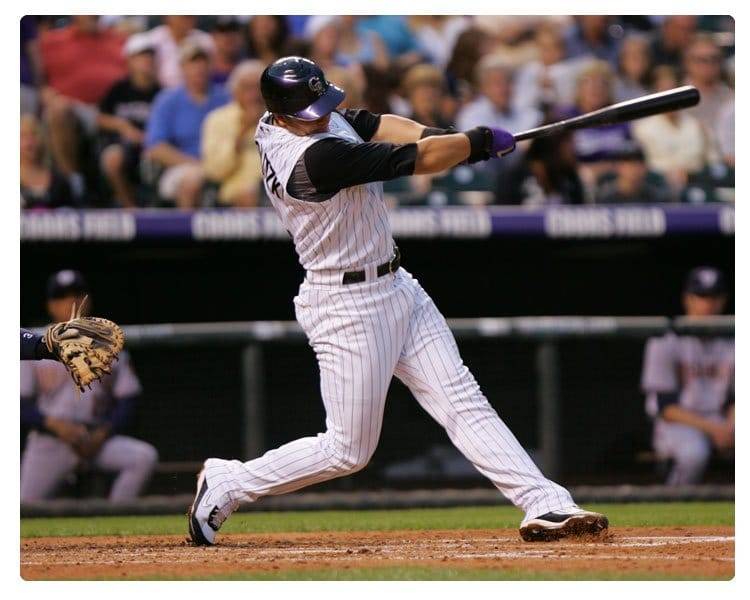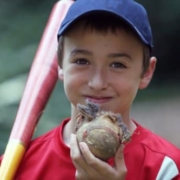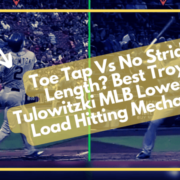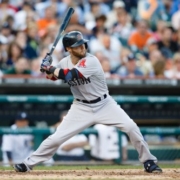Baseball Training VIDEO: #1 Mistake To Boosting BABIP
Baseball Training: 3 Easy Steps To More Barrel Time On Pitch Plane (Dylan’s Case Study)
![Baseball Training VIDEO: #1 Hitting Mistake To Boosting BABIP [Case Study]](https://hittingperformancelab.com/wp-content/uploads/2014/11/baseball-training-pitch-plane-dylan-case-study.png)
One of my online lessons Dylan from South Florida. Notice the change in front knee bend at landing (swings are synced).
- Higher BABIP (or Batting Average on Balls In Play), AND
- Cutting down on strikeouts.
In this baseball training video, we’re going to lengthen barrel time on pitch plane by tweaking these THREE things:
- Importance of landing gear (setting the stage),
- When does the barrel accelerate? (enter pitch plane early), AND
- Timing of Power-V (stay on pitch plane)…
Difference in pitch plane between baseball and fastpitch softball? Yep! Pitch plane is an imaginary line from the pitcher’s release point to the catcher’s glove. In baseball, the pitcher’s release point is raised 10 inches (by regulation). In fast-pitch, a pitcher’s release point is at about the pitcher’s hip, while standing on flat ground. So there’s not as distinct a downward pitch plane in fast-pitch softball, as there is in baseball.
Importance of Landing Gear (setting the stage)

Vlad Guerrero (.316 career BABIP) landing with bent front knee. Photo courtesy: Past Time Athletics (YouTube)
Foot work is pretty high on my action item list in sitting down with a new hitter. Initial baseball training boils down to getting on the plane of the pitch by bending the knees:
- Fight Position – at landing front knee should be bent and stacked over the ankle.
- Final Turn – front leg straightens while back leg bends to about 90-105 degrees.
Consider something Homer Kelly said about this in his book The Golfing Machine:
“KNEE ACTION – Knee Action is classified on the basis of (1) combinations of bent and straight conditions and (2) the Reference Points selected at which these combinations occur. The combination and the Reference Points selected will determine the slanting of the Hips during the Pivot. The slant is up in the direction of a straightened Knee. The slant of the Hips affects the degree of the Hip Turn. Actually, the primary function of Knee Action – as with Waist Bend – is to maintain a motionless Head during the Stroke.”
When Does the Barrel Accelerate? (enter pitch plane early)

Victor Martinez (.316 career BABIP) quick on the pitch plane…check out how close his barrel is to catcher’s glove! Photo courtesy: ExplosiveBaseballSwing.com
“Be short to the ball!” is one of those cues that gets misinterpreted. Most baseball training pro instructors, players, and coaches preach being short to the ball. But what they should be saying is be quick to the pitch plane with the barrel. Because of the following natural factors…
- Gravitational Forces,
- Conservation of Angular Momentum,
- Centripetal Forces (center-seeking) AND Centrifugal Forces (center-fleeing)…
…A barrel CANNOT efficiently accelerate, being pushed by the hands to a moving ball. Watch/read these other Hitting Performance Lab posts for WHY:
- Youth Baseball ALERT: Hitting Fix For Bat Drag, and
- Does Chris Davis Hit Backwards? Common Mistake #4.
Timing of Power-V (stay on pitch plane)

Troy Tulowitzki (.320 career BABIP) in the Power-V well passed contact. Photo courtesy: MLB.com
The last baseball training piece to boosting BABIP and reduce strikeouts is to keep the barrel on pitch plane. “Power-V” is another misinterpreted coaching cue. Hitters are sometimes told to be at extension with both arms at impact. This is false. The Power-V should be achieved 3-9 inches passed impact, depending on pitch location and speed. This ensures maximum inertial force transferred from body to barrel to ball.
The bottom line?
The #1 baseball training MISTAKE to increasing BABIP and cutting down on strikeouts is to “be short to the ball”. What you want the hitter to do is:
- Set plane early by landing with a bent front knee,
- Maintain plane during Final Turn by straightening front knee and bending back one,
- Be quick with barrel to pitch plane, and
- Stay on plane by getting to Power-V passed impact.
- Fix Late Swings Fast: 2025 Pitch Recognition & See-Decide-Swing Training for Youth Baseball Power Hitters - October 6, 2025
- Safe Youth Weighted Bat Training: Proven Overload/Underload Drills to Increase Exit Velocity in Games Starting Tonight - September 29, 2025
- AI Coaching Course 2025: Youth Baseball & Softball Practice Plan + Off-Season & In-Season Workout Builder Fast - September 23, 2025













Joey … you put so much into each presentation, that I have to watch it several times to pick it all up. And in all of your work, you jam many ideas into a small space, and each one of those can be talked about at length. For this one, you said a few things that sparked an interest with me. The first is … you used the word “throw” in reference to Martinez ‘throwing’ the barrel toward the ground to use gravity to help generate early momentum. The concept of throwing the barrel needs to be extended to the entire swing. He’s not only throwing it downward, but throwing it forward as well. If you stop the tape at about 259 (when you talk about throwing it down), and mark the extent of his hip rotation, you can see from there on there is very little, if any more, hip rotation, and very little torso rotation when compared to the distance the bat head travels from that point. He’s extending his arms from there, which is the second point of interest at this time … arm extension.
It’s hard to compare the swing of a young guy with a top pro, but in the case of your student, I think Dylan is suffering the results of coaches telling him that the arms are not as important as the hips in a swing – or at least putting more emphasis on the rotation aspect of the swing, and over-looking the bat head. I also think he could be feeling the ill effects of hitting off a pitching machine (which can harm your swing if not done right). It looks to me like he’s done a lot of work on rotation and not enough on his arms. His rotation continues right to, and through the swing and that is evidenced by his finish.
If you stop the tape at 401, and mark where they are you can see this. Then let it go to 406 and compare their positions. Dylan is ‘swinging’ the bat by means of rotation, and Martinez is throwing the bat head at the ball using primarily his arms. His body has stopped moving, and Dylan’s is still going. The young hitter is swinging the bat using his body like a door that is opening, and you can see where he is by 406. His bat is waist high, he hasn’t engaged his arms, and he’s rotated toward the first base dugout.
There are many other contributing factors, but I won’t say anything about them now in the interest of getting long winded. Good piece Joey, and very good work on this young guy. If Dylan is reading this … do what Joey says and you’ll hit the ball better, and harder. And remember … “Don’t practise until you can do it right … practise until you can’t do it wrong.”
Bob, another great comment. Yes, the challenge with these videos is being short and snappy, fitting everything into a 3-4 minutes video. I can’t elaborate like I would in person. I totally agree that Dylan’s swing right now is optimized for high angular velocity (turning speed). There’s little shift to increasing his inertial force, or like you said, focusing on extending the arms. I wish I had time to show the difference in his prior and recent swings at extension because he’s doing much better. We’re still working on it. He’s a very responsive athlete, so he’ll see big changes in the coming months for sure. And I love that last quote Bob!
Joey, I really like your work.
In this case i see Dylan not having enough tilt. If he were to have more bend at his waist he would get his bat on plane earlier.
Martinez is a little in front of an outside pitch which caused hit to reach for this pitch. This is not a good example of optimum position at point of contact in which he would have more bend in his back arm at contact and he would be able to complete his hip turn. The fact that it was an outside pitch caused him to stop his hip turn,
Jon, great assessment. Yes, this pitch was outer-third of the plate, so Victor Martinez was a little more extended at impact. When you talk about Dylan’s bend at the waist, are you talking about at the start or at impact?
I don’t see the pitch being outside. Look at how far the bat head is below his hands at contact, and where it hits on the bat. It’s not even close to the end – he’s got the sweet spot on a bullseye. The pitch is down in the zone, but more down the middle as I see it. Just look at where he finishes! He’s golf swinging this baby. He’s extending his arms because he chooses to extend them, and he has that point of contact because he’s picked it specifically so that he can get to near full extension at contact. That is where you are going to maximize bat speed. It didn’t happen by accident, but by design. The only time pros have their arms less than 90% of full extension at contact is when they are late, or are jammed inside and are trying to keep the ball fair. You’re right that he’s out in front, but again, he’s doing that with purpose. The speed of the bat is accelerating exponentially, and if you can make contact later in the swing there is a greater potential for speed. That’s why it’s difficult to hit OP – because the bat speed hasn’t matured. There are follow-through princilpes in human kinetics that dictate the transfer and exit of power – and we must obey them.